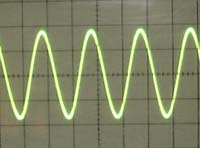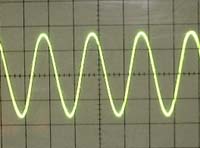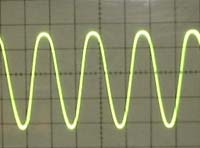Application Notes
SV811-3 Single-Ended 12W Monaural Power Amplifier
This section introduces one example using R core audio interstage and output
transformer: SV811-3 Single-Ended 12W Monaural Power Amplifier.
This is a high power amplifier that outputs 12W being 50% more than 300B. The
main feature, however, is first and foremost easy to make by its configuration
of both the power supply voltage less than 500V and the inexpensive parts
commonly available in the market.
Rated Performance of SV811-3 Single-Ended 12W Monaural Power Amplifier
|
Maximum output |
12W |
|
Frequency bandwidth (1W) |
15Hz to 40KHz +0,-3db |
|
Damping factor |
3.8 |
|
Distortion factor (1KHz) |
1W : 0.3%, 10W: 6.%, 12W : 9% |
|
Residual noise level |
0.9mV (without weighting network) |
SV811-3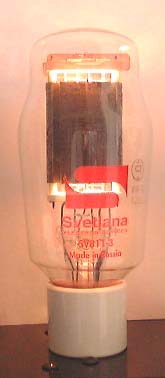
SV811-3 is a power tube developed by Svetlana, Russia
basing on the transmitting tube 811A. This is a very beautiful tube having a
brightly shining thoriated-tungsten filament with plain plate encapsulated in a
large-size perfectly transparent glass tube without getter.
The combination of thoriated-tungsten filament, plain plate, and low MU
is accomplished by old original type tubes such as 211 and 845 being highly
evaluated as high-quality sound tubes. SV811-3 is a rare currently produced
tube enabling to appreciate the sound of the combination of thoriated-tungsten filament, plain plate, and low
MU
Main rated characteristics of the tube are as follows.
|
Plate dissipation |
65W |
|
MU |
3.5 |
|
Mutual conductance |
1700uS |
|
Plate resistance |
2Kohms |
|
Maximum plate voltage |
800V |
|
Maximum plate current |
160mA |
|
Filament voltage |
6.3V |
|
Filament current |
4A |
This tube is lager than famous 300B. However,
- Typical operation designated by the tube manufacturer requires the supply voltage 500V or above.
- Also requires a high voltage drive source.
- Requires high impedance output transformer because of its high plate resistance.
- Hum noise is not negligible because of high filament voltage.
We can enumerate several difficulties for using it as
above. But if these disadvantages are overcome, this tube represents aspects
more adorable than 300B in addition to brightly shining operation outlook.
Design objective of Amplifier
The design objectives of this amplifier are high-performance, easy to collect component parts, and easy to build.
- To obtain the output power greater and 300B amplifier
- To lower the supply power voltage 500V or below
- To configure with easy-to-collect multipurpose parts on the market
- To select monaural construction to downsize the weight and dimensions for easy-building
Amplifier Configuration
1. Overall configuration
6SL7 voltage amplification --- 6L6GC triode connection diver --- interstage transformer (1: 0.9) --- SV811-3 fixed bias --- output transformer 5Kohms
2. Output stage
The tube operation is class A2 that is driven up to grid +
field in order to obtain the power efficiently with the supply power voltage
500V or below. Plus, fixed bias system is employed for efficient use of the
supply power voltage.
The operating condition of the output stage is as follows.
|
Plate voltage |
460V |
|
Plate current |
70mA |
|
Grid voltage |
-75V |
|
Load |
5Kohms |
Up to about 5W, the operation is class A1 and from 5W and
above class A2 that is driven into grid + field. The swing voltage at the grid
is about +35V when outputting the maximum power. The required input voltage at
this point is 220V peak-to-peak, namely about 78Vrms. Since the grid current
flows in grid + field, a powerful driver stage is necessary not to suffer the
grid current and to supply high voltage.
Output transformer is RW-20. As
this is 3-stage amplifier, the primary and secondary of the output transformer
is connected in negative phase connection.
3. Fixed bias circuit using MOS-FET
The fixed bias circuit must absorb the grid current flowing
in the grid of SV811-3 not only supplies the negative voltage for biasing the
grid of SV811-3. When the grid is swung into grid + field, the signal is
rectified by the grid and thus generating DC component. By this, the grid
voltage goes further to negative side, which reduces the plate current and thus
suppresses the output increase. In order to increase efficiently the output
power, the fixed bias circuit must retain the bias voltage constant even if the
grid current flows. In this amplifier, a MOS-FET source follower circuit is
installed after the normal fixed bias circuit to absorb the grid current.
The reason of lay outing Nch MOS-FET on the opposite side to the general
voltage regulator source follower is that the grid current works to increase
the bias voltage not to decrease it. Nch MOS-FET consumes the current from the
grid that works to increase the bias voltage and thus keeps the voltage on the
grid constant.
4. Driver stage
The combination of 6L6GC triode connection and RC-20 interstage transformer obtains high power without being affected by the grid current. The connection
of RC-20 interstage transformer is primary in series and secondary in parallel
positive phase connection. Slight step-down operation 1: 0.9 enables high
current supply. The secondary of RC-20 is open (without load). This enables
both to obtain the natural and unconstrained sound quality proper to open
operation and to feed entire supply current from the interstage transformer
to the grid of power tube.
The operating condition of 6L6GC is effective plate voltage 290V, plate current
24mA. In the circuit diagram, the 1st pin (NC) of 6L6GC is connected
to the 6th pin. This is a gadget to use as driver also EL34 (6CA7)
that has independent suppressor grid.
5. Voltage amplification stage (first stage)
The voltage amplification stage uses 6SL7-1/2. The half unit is left unused
and all electrodes of this unit are grounded. By setting high plate load
resistance, 240Kohms, to obtain high gain and large time constant of high
frequency, an appropriate stagger ratio is obtained between the time constants
of high frequency of driver stage and output stage.
6. Negative feedback
Despite of the existence of interstage transformer, this
amplifier employs 5dB major negative feedback. This is because the damping
factor without negative feedback is only about 1.7 due to the higher plate
resistance of SV811-3 compared to 300B etc. By employing 5dB negative feedback,
the damping factor can be set at an appropriate level: about 3.7.
Good phase characteristics at high frequency both of interstage and output
transformer as well as appropriate stagger ratio with the first stage make
possible a stable negative feedback across the circuit that contains two
transformers. No phase correction is necessary for feedback.. Stable Square wave response
has been obtained.
7. Power supply
Power transformer is a reasonable PCM-170M of Noguchi. DC 470V is obtained by diode center tap rectification of AC 350V. Choke coil is a multipurpose PCM-1520 of Noguchi. Electrolytic capacitor 400V 100uF is a small-sized general purpose radial type made by unicon that has once been distributed by Softone.
Negative voltage supply for fixed bias is -405V that is made from AC 290V
center tap rectification.
Power supply 6.3V 4A for SV811-3 filament must be DC because AC generates
considerable hum noise. Efficiency is required for high current. Two windings
6.3V 3A of PCM-170M are connected in series and then rectified using the
midpoint as center tap by 5A schottky barrier diode F5KQ100. This reduces
by half the loss caused by diode compared to bridge rectification. filter
consisting of 0.1ohms and 10000uF X 2 after the rectification reduces by
half the ripple component.
Circuit diagram
Full circuit diagram(SV811SEM.GIF)
Amplifier chassis, overview, and internal wiring
Chassis is a Softone's MS1. Shorter
sides are used for front and rear. Setting two chassis side by side as stereo
amplifier will have the same width as full size component amplifier.
As SV811-3 is an
entirely transparent glass tube without getter, we selected 6L6GC and 6SL7 that
have no getter on the top of the glass tube. 6L6GC is no brand made in Russia
and 6SL7 is made by NEC for communication.
On the right end is an ammeter indicating the current of power tube. The knob
just below the ammeter is a potentiometer for bias adjustment. Between the
potentiometer for bias adjustment and the power tube is a potentiometer as ham
balancer.
Top view
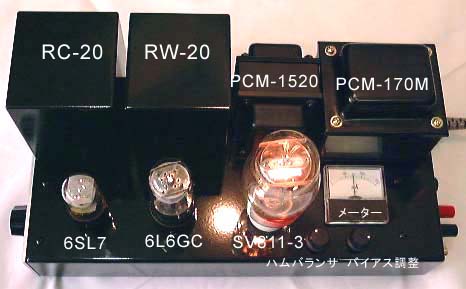
Front, rear, and side
view
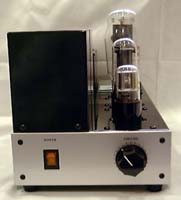
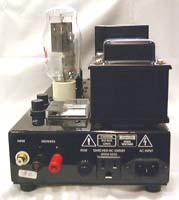
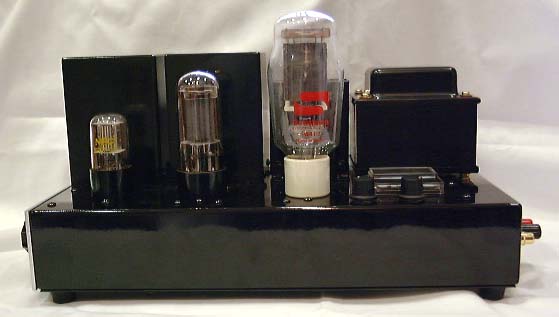
Internal
wiring
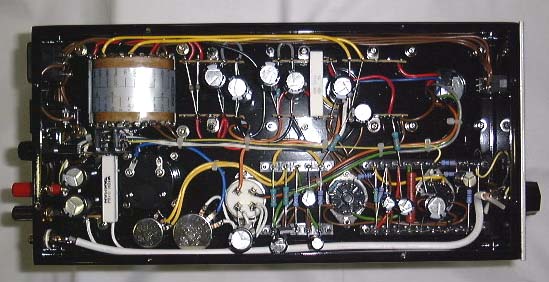
Instruction for building the amplifier
- We recommend one-point grounding at the fixing screw of the first stage 6SL7 socket. Two-point grounding that connects to ground also near the power transformer is not recommendable.
- Since the filament requires high power, the residual noise level varies depending on the ground wiring sequence. Observe the wire connecting sequence indicated in the wiring diagram to wire the ground line.
- Since the first stage 6SL7 has high impedance, it is inducible from outside. Move your hand closer to 6SL7, and then the hum noise increases. Select a 6SL7 that is hard to be induced. Another half of 6SL7 is left unused. Connect to ground the cathode, grid, and plate of this unused half unit.
- Mount a small heat sink to diode F5KQ100 for power supply of SV811-3 filament.
Impression on sound quality
Large size ST tube under shining operation is, first of
all, very much impressive. Beautiful operating feature of SV811 surely puts
300B in the shade.
First impression when starting to listen to music is good sound quality at
fortissimo. Loud sound comes out without being deformed and whispering sound
behind the loud sound can be heard without being masked. Consequently, the
dynamic range of musical performance becomes audibly expanded.
Sound balance is toward mid and low. It seems that modest high range stands on
clear mid range and solid low range. High clearness of mid range has vocal
heard quite vivid.
Is it an advantage of two monaural amps? Both auditory sound and localization
are superior representing sound images lined up in depth between the
loudspeakers.
Measurement results
1. Input-output characteristics
Output increases linearly up to 12W. The waveform does not lose shape drastically beyond 12W and the output increases gradually up to about 15W.
|
|
|
|
2. Frequency characteristics
Even without NFB, the frequency bandwidth is 25Hz to 20KHz (+0, -3dB) covering
approximately the audible frequency range. Despite of transformer coupled
2-stage circuits and open secondary winding of interstage transformer,
the attenuation characteristics are ideal both at low and high ends presenting
no peculiar peaks or dips. The low-end attenuation at 10W output is due
to the saturation of output transformer.
With 5dB NFB, the bandwidth expands 15Hz to 40KHz (+0,-3db) keeping a fair characteristics without peaks or dips.
3. Square wave response
100Hz |
1KHz |
10KHz |
|
|
6ohms + 0.047uF |
6ohms + 0.1uF |
6ohms + 0.47uF |
6ohms + 1uF |
Load = only capacitance (10KHz)
|
|
Only 0.047uF |
Only 0.1uF |
Only 0.47uF |
Only 1uF |
In each case, the waveform is fine. The output is quite stable with capacitance load. 4. Distortion factor characteristics Without NFB
It proves that SV811-3 has excellent linearity and a low distortion tube equivalent to 300B. The curves of 100Hz and 1KHz represent a low distortion in wide range, which suggests effective distortion canceling. On reaching about 5W, the operation switches from class A1 to A2 where the grid current flows. At this transition point, the distortion factor continues smoothly. This proves powerful driver stage and excellent performance of bias circuit that absorbs the grid current.
With 5dB NFB
1KHz 1W : 0.22%, up to 4W : 1% or below, 10W : 6%, 12W : 9%
Distortion component analysis by FFT
|
|
|
|
|
|
Both 100Hz and 1KHz contain lower harmonic components around 4th harmonic up to 1W and the higher degree becomes the lower the distortion, which presents excellent harmonic distortion characteristics. At output 6W, many higher harmonic components appear and odd number degree components are greater than even number degree components. This indicates that the waveform is deformed by the influence of grid current and other factors.
5. Residual noise level
0.9mV of residual noise level is satisfactory for the power
tube having 6.3V filament. The components of residual noise would be 50% from
filament and 50% from induction hum of first stage tube 6SL7. As the noise
level varies considerably depending on the first stage 6SL7, it is necessary to
select no-noise tube.
6. Damping factor
Without non-NFB, the damping factor is low, 1.7. There is concern that it comes short of damping in low range for some kinds of speakers. 5dB NFB increases the damping factor to 3.8, suitable for various kinds of speakers.
Parts to use
1. Vacuum tube
SV811-3 is made by Svetlana, Russia. San-ei Electric (Phone +81-3-3251-0232) on the 3rd floor of Tokyo Radio Department Store (in AKIHABARA) sells this
tube at a bargain price @ 3,500 yen. This price is absolutely a
great deal for this tube.6L6GC is a no brand Russian tube. Any brand may be
acceptable because of its light operation. But 6L6, 6L6G, 6L6GA, 6L6GB, etc.
cannot be used because about 400V is charged on the tube at power on until the
tube warms up and the plate current starts to flow. This voltage exceeds the
maximum rating of these tubes. Be sure
to use 6L6GC.We use NEC brand 6SL7 in stock. It is necessary to select a tube of low
induction hum noise. Buy several types and pick up low noise tubes.
2. Resistor
Most resistors (2W, 5W) are incombustible (metal oxide film) resistors. Its
performance and stability may be suitable for the tube amplifier operating in
high voltage. 10W resistors are wire wound type.
3. Capacitor
Electrolytic capacitors are all right with reasonable multipurpose small
size type. Capacitors made in recent years (within a couple of years) would
be better than old large size type. It is nothing unusual that multipurpose
capacitors having quick turnover of sales achieve better results than special
audio capacitors.
4. Transformer
Interstage transformer is Softone RC-20 and output transformer is Softone RW-20.
It would be possible that the interstage transformer can be replaced with Tango
NC-20F, and the output transformer with XE-20S or FW-20S. However, the
stability of NFB must be checked on the amplifier.
Power transformer is Noguchi PCM-170M and choke coil is Noguchi PCM-1520. Both are reasonable and good quality products.
5. Chassis
We use Softone MS-1. This is
a punched and painted easy-to-build chassis.
6. Wires
We recommend UL1015 standard wires . AWG22 meets the case for low current
path wiring and AWG20 for high current path wiring. Too large size wire
would be difficult for wiring.
7. Parts list
The table below shows the parts necessary for one unit of
monaural amplifier. Only main parts are listed. Screws, wires, and small parts
omitted in the table are also necessary. Please note that there are unknown or
uncertain descriptions on some manufacturers, shops, and prices.
|
Parts No. |
Spec/model No. |
Type |
Brand |
Shop |
Price in yen |
|
C01 |
100P |
Dip mica capacitor |
Soushin |
CR |
90 |
|
C02 |
1000uF16V |
Small size radial electrolytic |
Nichemi |
||
|
C03 |
100uF400V |
Small size radial electrolytic |
Unicon |
Softone |
180 |
|
C04 |
47uF250V |
Small size radial electrolytic |
Unicon |
Softone |
100 |
|
C05 |
10uF250V |
Small size radial electrolytic |
Nichemi |
||
|
C06 |
47uF250V |
Small size radial electrolytic |
Unicon |
Softone |
|
|
C07 |
22uF450V |
Small size radial electrolytic |
Nichemi |
||
|
C08 |
10uF250V |
Small size radial electrolytic |
Nichemi |
||
|
C09 |
47uF250V |
Small size radial electrolytic |
Unicon |
Softone |
100 |
|
C10 |
100uF400V |
Small size radial electrolytic |
Unicon |
Softone |
180 |
|
C11 |
100uF400V |
Small size radial electrolytic |
Unicon |
Softone |
180 |
|
C12 |
100uF400V |
Small size radial electrolytic |
Unicon |
Softone |
180 |
|
C13 |
100uF400V |
Small size radial electrolytic |
Unicon |
Softone |
180 |
|
C14 |
100uF400V |
Small size radial electrolytic |
Unicon |
Softone |
180 |
|
C15 |
10000uF16V |
Small size radial electrolytic |
Tohshin |
Sengoku |
150 |
|
C16 |
10000uF16V |
Small size radial electrolytic |
Tohshin |
Sengoku |
150 |
|
C17 |
10000uF16V |
Small size radial electrolytic |
Tohshin |
Sengoku |
150 |
|
D01 |
3TH62 |
1500V3A diode |
Toshiba |
Wakamatsu |
250 |
|
D02 |
3TH62 |
1500V3A diode |
Toshiba |
Wakamatsu |
250 |
|
D03 |
1N4007 |
1000V1A diode |
GI |
Sengoku |
20 |
|
D04 |
1N4007 |
1000V1A diode |
GI |
Sengoku |
20 |
|
D05 |
F5KQ100 |
100V5A schottky barrier diode |
Wakamatsu |
125 |
|
|
D06 |
F5KQ100 |
100V5A schottky barrier diode |
Wakamatsu |
125 |
|
|
Q01 |
2SK1758 |
500V Nch MOS-FET |
NEC | ||
|
R01 |
100K/2W |
Incombustible (metal oxide film) resistor |
Takman |
Sengoku |
20 |
|
R02 |
10K/2W |
Incombustible (metal oxide film) resistor |
Takman |
Sengoku |
20 |
|
R03 |
2.7K/2W |
Incombustible (metal oxide film) resistor |
Takman |
Sengoku |
20 |
|
R04 |
10/2W |
Incombustible (metal oxide film) resistor |
Takman |
Sengoku |
20 |
|
R05 |
240K/2W |
Incombustible (metal oxide film) resistor |
|||
|
R06 |
1K/2W |
Incombustible (metal oxide film) resistor |
Takman |
Sengoku |
20 |
|
R07 |
3.9K/5W |
Incombustible (metal oxide film) resistor |
|||
|
R08 |
100/2W |
Incombustible (metal oxide film) resistor |
Takman |
Sengoku |
20 |
|
R09 |
Missing |
||||
|
R10 |
330/2W |
Incombustible (metal oxide film) resistor |
Takman |
Sengoku |
20 |
|
R11 |
51K/2W |
Incombustible (metal oxide film) resistor |
Takman |
Sengoku |
20 |
|
R12 |
5.1K/2W |
Incombustible (metal oxide film) resistor |
Takman |
Sengoku |
20 |
|
R13 |
51K/2W |
Incombustible (metal oxide film) resistor |
Takman |
Sengoku |
20 |
|
R14 |
100K/2W |
Incombustible (metal oxide film) resistor |
Takman |
Sengoku |
20 |
|
R15 |
68K/2W |
Incombustible (metal oxide film) resistor |
Takman |
Sengoku |
20 |
|
R16 |
20K/2W |
Incombustible (metal oxide film) resistor |
Takman |
Sengoku |
20 |
|
R17 |
20K/2W |
Incombustible (metal oxide film) resistor |
Takman |
Sengoku |
20 |
|
R18 |
51K/2W |
Incombustible (metal oxide film) resistor |
Takman |
Sengoku |
20 |
|
R19 |
3K/10W |
Wire wound resistor |
|||
|
R20 |
510K/2W |
Incombustible (metal oxide film) resistor |
Takman |
Sengoku |
20 |
|
R21 |
510K/2W |
Incombustible (metal oxide film) resistor |
Takman |
Sengoku |
20 |
|
R22 |
510K/2W |
Incombustible (metal oxide film) resistor |
Takman |
Sengoku |
20 |
|
R23 |
510K/2W |
Incombustible (metal oxide film) resistor |
Takman |
Sengoku |
20 |
|
R24 |
0.1/10W |
Wire wound resistor |
Takman |
Sengoku |
150 |
|
T01 |
RC-20 |
Interstage transformer |
Softone |
Softone |
9800 |
|
T02 |
RW-20 |
Single-ended type output transformer5Kohms20W |
Softone |
Softone |
9800 |
|
T03 |
PMC1520H |
Choke coil |
Noguchi |
Noguchi |
4500 |
|
T04 |
PCM170M |
Power transformer |
Noguchi |
Noguchi |
7900 |
|
V01 |
6SL7 |
NEC |
|||
|
V02 |
6L6GC |
Russia |
|||
|
V03 |
SV811-3 |
Svetlana |
San-ei |
3500 |
|
|
VR01 |
100KA RV24YN |
Single potentiometer |
Cosmos |
350 |
|
|
VR02 |
50B/2W RV30YN |
Single potentiometer |
Cosmos |
500 |
|
|
VR03 |
50KB RV24YN |
Single potentiometer |
Cosmos |
350 |
|
|
US socket 2 pieces |
QQQ |
200 |
|||
|
UX socket 1 piece |
400 |
||||
|
4L1P lug 6 pieces |
|||||
|
2L1P lug 2 pieces |
|||||
|
Small heat sink 2 pieces |
Mounted to F5KQ100 |
||||
|
2A fuse 1 piece |
|||||
|
MS1 chassis |
Painted and punched, with exterior parts and ammeter |
Softone |
Softone |
11800 |
